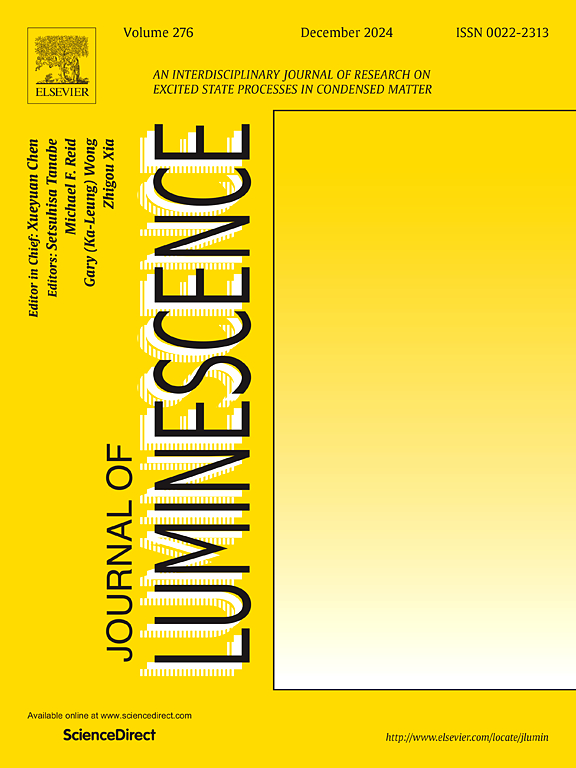新型蓝蓝色发光Na18Ca13Mg5(PO4)18:Eu2+荧光粉的机器学习分析与发现
IF 3.6
3区 物理与天体物理
Q2 OPTICS
引用次数: 0
摘要
目前,发现先进发光材料的数据驱动方法受到相当多的关注,这是由于加速材料开发时间表和提供对材料特性的多方面见解的潜力所驱动的。本研究利用机器学习技术建立了Eu2+活化aibiipo4型荧光粉发射波长的预测模型,从而提出了合理的设计策略。此外,通过合成一种新型Na18Ca13Mg5(PO4)18:Eu2+荧光粉,并将其发射波长与模型预测值进行比较,对模型的性能进行了严格的评估,结果与模型的预测值一致。化合物Na18Ca13Mg5(PO4)18具有glaserite型晶体结构,属于三角晶体体系的R-3m空间群。Eu2+激活的Na18Ca13Mg5(PO4)18荧光粉在近紫外区表现出250 ~ 400 nm的强宽带吸收,在365 nm激发下发出明亮的蓝绿色发光。制备的w-LED灯的高Ra(93.3)和低相关色温(CCT: 5096 K)值表明Na18Ca13Mg5(PO4)18:Eu2+可以作为一种有前途的蓝-青色发光荧光粉用于全光谱健康照明。本文章由计算机程序翻译,如有差异,请以英文原文为准。
Machine learning analysis and discovery of novel blue-cyan-emitting Na18Ca13Mg5(PO4)18:Eu2+ phosphor
Currently, data-driven methodologies for discovering advanced luminescent materials are receiving considerable focus, driven by the potential to expedite material development timelines and provide multi-faceted insights into material properties. This study implements machine learning to develop a predictive model for emission wavelengths in Eu2+-activated AIBIIPO4-type phosphors, thereby advancing rational design strategies. Furthermore, the model's performance is rigorously evaluated by synthesizing a novel Na18Ca13Mg5(PO4)18:Eu2+ phosphor and comparing its emitting wavelength with the value predicted by the model, showing satisfactory agreement. The compound Na18Ca13Mg5(PO4)18 exhibits a glaserite-type crystal structure and belongs to the R-3m space group of the Trigonal crystal system. The Eu2+-activated Na18Ca13Mg5(PO4)18 phosphor demonstrates intense broadband absorption spanning 250–400 nm in the near-ultraviolet region, emitting bright blue-cyan luminescence under 365 nm excitation. The high Ra (93.3) and low correlated color temperature (CCT: 5096 K) values of the as-fabricated w-LED lamp indicate that Na18Ca13Mg5(PO4)18:Eu2+ can act as a promising blue-cyan-emitting phosphor for full-spectrum healthy lighting applications.
求助全文
通过发布文献求助,成功后即可免费获取论文全文。
去求助
来源期刊

Journal of Luminescence
物理-光学
CiteScore
6.70
自引率
13.90%
发文量
850
审稿时长
3.8 months
期刊介绍:
The purpose of the Journal of Luminescence is to provide a means of communication between scientists in different disciplines who share a common interest in the electronic excited states of molecular, ionic and covalent systems, whether crystalline, amorphous, or liquid.
We invite original papers and reviews on such subjects as: exciton and polariton dynamics, dynamics of localized excited states, energy and charge transport in ordered and disordered systems, radiative and non-radiative recombination, relaxation processes, vibronic interactions in electronic excited states, photochemistry in condensed systems, excited state resonance, double resonance, spin dynamics, selective excitation spectroscopy, hole burning, coherent processes in excited states, (e.g. coherent optical transients, photon echoes, transient gratings), multiphoton processes, optical bistability, photochromism, and new techniques for the study of excited states. This list is not intended to be exhaustive. Papers in the traditional areas of optical spectroscopy (absorption, MCD, luminescence, Raman scattering) are welcome. Papers on applications (phosphors, scintillators, electro- and cathodo-luminescence, radiography, bioimaging, solar energy, energy conversion, etc.) are also welcome if they present results of scientific, rather than only technological interest. However, papers containing purely theoretical results, not related to phenomena in the excited states, as well as papers using luminescence spectroscopy to perform routine analytical chemistry or biochemistry procedures, are outside the scope of the journal. Some exceptions will be possible at the discretion of the editors.
 求助内容:
求助内容: 应助结果提醒方式:
应助结果提醒方式:


